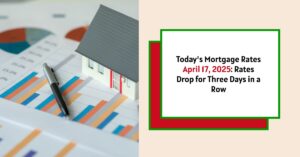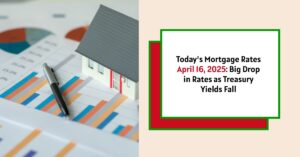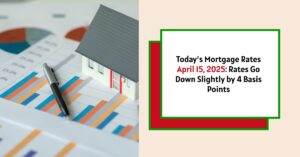If you've been holding your breath waiting for the right time to buy a home, you can finally exhale a little. After a period of economic jitters that sent them soaring, mortgage rates have settled back under 7%. This offers a glimmer of hope for prospective homebuyers navigating the often-turbulent real estate market.
The last few weeks have felt like a rollercoaster, haven't they? One minute you think you've got a handle on things, the next minute the market throws you a curveball. But before you start packing boxes, let's dive deeper into what's been happening and what it really means for you.
Mortgage Rates Go Down and Stay Below 7% After Volatile Week
Why the Wild Ride?
So, what caused this sudden spike and subsequent dip in mortgage rates? Well, it all boils down to economic uncertainty. Think of it like this: the global economy is a complex machine with lots of moving parts. When one part sputters, it can affect everything else.
According to Jessica Lautz, deputy chief economist at the National Association of REALTORS® (NAR), economists are keeping a close eye on the bond market, especially since countries like China hold a significant amount of U.S. bonds. The trade war adds another layer of complexity. When bond prices fall, mortgage rates tend to rise.
And Mike Fratantoni, senior vice president and chief economist at the Mortgage Bankers Association (MBA), pointed out that economic uncertainty can make potential buyers hesitant. This hesitation was reflected in a 5% drop in mortgage applications last week.
Here's a breakdown of the factors at play:
- New tariff policies: Uncertainty surrounding trade deals often leads to market volatility.
- Stock market fluctuations: A volatile stock market can signal broader economic instability.
- Bond market shifts: As Lautz mentioned, changes in the bond market directly impact mortgage rates.
- Global Economic factors : War, political instability and high inflations.
The Good News: Spring is Sprung and Inventory is Up
Even with the rate fluctuations, there are signs that the spring home buying season is off to a strong start. Despite the weekly dip, mortgage applications for home purchases are still 13% higher compared to the same week last year.
Sam Khater, Freddie Mac’s chief economist, aptly describes the situation, saying, “It's a clear sign that this year’s spring home buying season is off to a stronger start.”
Lautz also highlights a significant advantage for today's buyers: “unsold inventory is up by double digit percentages compared to a year ago.” This means you have more choices than buyers have had in years. More options on the market means potentially less competition and more negotiating power.
Think of it this way:
- More homes for sale: Gives you more options and potentially more room to negotiate.
- Stronger buying season: Suggests that people are still active in the market, despite economic concerns.
The ARM Race: Adjustable-Rate Mortgages Gain Popularity
With those higher rates, it’s no surprise that more buyers are turning to adjustable-rate mortgages (ARMs). The share of ARM applications jumped a full percentage point in just one week, reaching nearly 10% of all mortgage applications – the highest since November 2023!
ARMs offer a lower initial interest rate for a set period (usually 5 or 7 years), before adjusting to current market rates. As Fratantoni explains, “more borrowers are opting for the lower initial [payments] that come with an ARM.”
But is an ARM right for you? Here’s what you need to consider:
| Feature | Fixed-Rate Mortgage | Adjustable-Rate Mortgage (ARM) |
|---|---|---|
| Interest Rate | Remains constant for the life of the loan | Starts lower, then adjusts periodically |
| Payment Stability | Predictable monthly payments | Payments can change with interest rates |
| Risk | Lower risk if interest rates rise | Higher risk if interest rates rise after the fixed period |
| Best For | Borrowers who value stability and certainty | Borrowers who plan to move or refinance before the rate adjusts, or believe that rates will decrease |
I think that ARMs can be a smart move if you have a clear financial plan and understand the risks involved. If you plan to move or refinance before the rate adjusts, or if you believe that interest rates will fall in the future, an ARM could save you money in the short term. But if you're looking for stability and predictability, a fixed-rate mortgage is generally a safer bet.
Breaking Down the Numbers: What Does it Cost to Buy?
Let's get down to brass tacks: what does all of this mean in terms of your monthly mortgage payment?
According to Lautz, at this week’s 30-year average of 6.83%, a $400,000 home with a 20% down payment would result in a monthly mortgage payment of around $2,093. If you put down 10%, that payment jumps to $2,354.
Of course, these are just estimates. Your actual payment will depend on several factors, including:
- Credit score: A higher credit score typically means a lower interest rate.
- Down payment: A larger down payment reduces the loan amount and can lower your interest rate.
- Property taxes and insurance: These costs vary depending on the location and value of the home.
Read More:
Mortgage Rate Predictions for This Week: Expect Volatility, Not Relief
Mortgage Rates Likely to Go Down in the Short Term Due to Tariffs
A Closer Look at Current Mortgage Rates
Here’s a snapshot of the average mortgage rates reported by Freddie Mac for the week ending April 17:
- 30-year fixed-rate mortgages: Averaged 6.83%, up from 6.62% the previous week. A year ago, rates averaged 7.1%.
- 15-year fixed-rate mortgages: Averaged 6.03%, up from 5.82% the previous week. Last year at this time, rates averaged 6.39%.
The Takeaway: Don't Panic, But Be Prepared
The mortgage market can be unpredictable, and it’s easy to get caught up in the daily fluctuations. However, it's essential to stay calm and focus on your personal financial situation.
Here's my advice, based on my experience:
- Shop around: Get quotes from multiple lenders to find the best interest rate and terms.
- Consider your long-term goals: Think about how long you plan to stay in the home and whether an ARM or fixed-rate mortgage makes more sense for you.
- Get pre-approved: This will give you a better idea of how much you can afford and make you a more attractive buyer to sellers.
- Work with a trusted real estate agent: A good agent can help you navigate the market, negotiate offers, and find the right home for your needs.It's always advisable to consult with a financial advisor before making any major financial decisions. They can help you assess your individual circumstances and make informed choices based on your specific needs and goals.
Looking Ahead: What's Next for Mortgage Rates?
Predicting the future is always tricky, especially when it comes to something as complex as mortgage rates. However, keeping a close eye on economic indicators like inflation, bond yields, and employment data can give you a sense of where things might be headed.
According to experts like Lautz and Fratantoni, some of the key factors to watch include:
- Inflation: If inflation remains elevated, the Federal Reserve may continue to raise interest rates, which could push mortgage rates higher.
- Bond yields: Changes in bond yields can significantly impact mortgage rates.
- Economic growth: Strong economic growth could lead to higher interest rates, while a slowdown could push rates lower.
- Geopolitical events: Global events, such as trade wars or political instability, can also affect the market.
Final Thoughts
The journey to homeownership can be filled with ups and downs. But by staying informed, being prepared, and working with trusted professionals, you can increase your chances of success.
So, take a deep breath, do your homework, and remember that even after a wild ride, opportunities still exist in the real estate market. And with mortgage rates settling back under 7%, now might be the right time to jump in.
Work With Norada, Your Trusted Source for
Real Estate Investment in the U.S.
Investing in turnkey real estate can help you secure consistent returns with fluctuating mortgage rates.
Expand your portfolio confidently, even in a shifting interest rate environment.
Speak with our expert investment counselors (No Obligation):
(800) 611-3060
Also Read:
- Will Mortgage Rates Go Down in 2025: Morgan Stanley's Forecast
- Expect High Mortgage Rates Until 2026: Fannie Mae's 2-Year Forecast
- Mortgage Rate Predictions 2025 from 4 Leading Housing Experts
- Mortgage Rates Forecast for the Next 3 Years: 2025 to 2027
- 30-Year Mortgage Rate Forecast for the Next 5 Years
- 15-Year Mortgage Rate Forecast for the Next 5 Years
- Why Are Mortgage Rates Going Up in 2025: Will Rates Drop?
- Why Are Mortgage Rates So High and Predictions for 2025
- Will Mortgage Rates Ever Be 3% Again in the Future?
- Mortgage Rates Predictions for Next 2 Years
- Mortgage Rate Predictions for Next 5 Years
- Mortgage Rate Predictions: Why 2% and 3% Rates are Out of Reach
- How Lower Mortgage Rates Can Save You Thousands?
- How to Get a Low Mortgage Interest Rate?
- Will Mortgage Rates Ever Be 4% Again?











